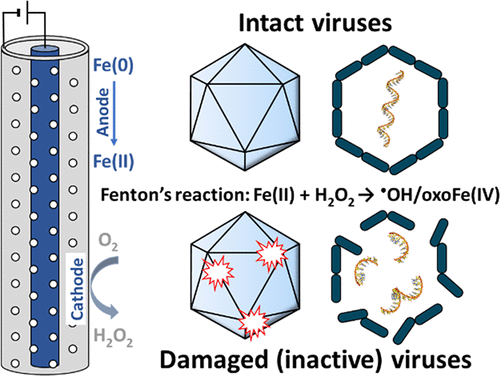当前位置:
X-MOL 学术
›
Environ. Sci. Technol.
›
论文详情
Our official English website, www.x-mol.net, welcomes your
feedback! (Note: you will need to create a separate account there.)
Virus Removal and Inactivation Mechanisms during Iron Electrocoagulation: Capsid and Genome Damages and Electro-Fenton Reactions
Environmental Science & Technology ( IF 10.8 ) Pub Date : 2021-09-21 , DOI: 10.1021/acs.est.0c04438 Kyungho Kim 1 , Jothikumar Narayanan 2 , Anindito Sen 3 , Shankararaman Chellam 1, 4
Environmental Science & Technology ( IF 10.8 ) Pub Date : 2021-09-21 , DOI: 10.1021/acs.est.0c04438 Kyungho Kim 1 , Jothikumar Narayanan 2 , Anindito Sen 3 , Shankararaman Chellam 1, 4
Affiliation

|
Virus destabilization and inactivation are critical considerations in providing safe drinking water. We demonstrate that iron electrocoagulation simultaneously removed (via sweep flocculation) and inactivated a non-enveloped virus surrogate (MS2 bacteriophage) under slightly acidic conditions, resulting in highly effective virus control (e.g., 5-logs at 20 mg Fe/L and pH 6.4 in 30 min). Electrocoagulation simultaneously generated H2O2 and Fe(II) that can potentially trigger electro-Fenton reactions to produce reactive oxygen species such as •OH and high valent oxoiron(IV) that are capable of inactivating viruses. To date, viral attenuation during water treatment has been largely probed by evaluating infective virions (as plaque forming units) or genomic damage (via the quantitative polymerase chain reaction). In addition to these existing means of assessing virus attenuation, a novel technique of correlating transmission electron micrographs of electrocoagulated MS2 with their computationally altered three-dimensional electron density maps was developed to provide direct visual evidence of capsid morphological damages during electrocoagulation. The majority of coliphages lost at least 10–60% of the capsid protein missing a minimum of one of the 5-fold and two of 3- and 2-fold regions upon electrocoagulation, revealing substantial localized capsid deformation. Attenuated total reflectance–Fourier transform infrared spectroscopy revealed potential oxidation of viral coat proteins and modification of their secondary structures that were attributed to reactive oxygen species. Iron electrocoagulation simultaneously disinfects and coagulates non-enveloped viruses (unlike conventional coagulation), adding to the robustness of multiple barriers necessary for public health protection and appears to be a promising technology for small-scale distributed water treatment.
中文翻译:

铁电凝过程中的病毒去除和灭活机制:衣壳和基因组损伤以及电芬顿反应
病毒去稳定和灭活是提供安全饮用水的关键考虑因素。我们证明,在微酸性条件下,铁电凝同时去除(通过扫絮凝)和灭活无包膜病毒替代物(MS2 噬菌体),从而实现高效的病毒控制(例如,20 mg Fe/L 和 pH 6.4 下的 5-logs在 30 分钟内)。电凝同时产生 H 2 O 2和 Fe(II),它们可能会触发电芬顿反应以产生活性氧,例如•OH 和能够灭活病毒的高价氧代铁 (IV)。迄今为止,水处理过程中的病毒减毒主要是通过评估感染性病毒粒子(作为斑块形成单位)或基因组损伤(通过定量聚合酶链反应)来探查的。除了这些评估病毒减毒的现有方法外,还开发了一种将电凝 MS2 的透射电子显微照片与其计算改变的三维电子密度图相关联的新技术,以提供电凝过程中衣壳形态损伤的直接视觉证据。大多数大肠杆菌噬菌体在电凝时丢失了至少 10-60% 的衣壳蛋白,至少丢失了 5 倍和 3 倍和 2 倍区域中的两个,揭示了大量的局部衣壳变形。衰减全反射-傅立叶变换红外光谱揭示了病毒外壳蛋白的潜在氧化及其归因于活性氧的二级结构的修饰。铁电凝同时消毒和凝固无包膜病毒(与传统凝固不同),增加了保护公共卫生所需的多重屏障的稳健性,似乎是小规模分布式水处理的有前途的技术。
更新日期:2021-10-06
中文翻译:

铁电凝过程中的病毒去除和灭活机制:衣壳和基因组损伤以及电芬顿反应
病毒去稳定和灭活是提供安全饮用水的关键考虑因素。我们证明,在微酸性条件下,铁电凝同时去除(通过扫絮凝)和灭活无包膜病毒替代物(MS2 噬菌体),从而实现高效的病毒控制(例如,20 mg Fe/L 和 pH 6.4 下的 5-logs在 30 分钟内)。电凝同时产生 H 2 O 2和 Fe(II),它们可能会触发电芬顿反应以产生活性氧,例如•OH 和能够灭活病毒的高价氧代铁 (IV)。迄今为止,水处理过程中的病毒减毒主要是通过评估感染性病毒粒子(作为斑块形成单位)或基因组损伤(通过定量聚合酶链反应)来探查的。除了这些评估病毒减毒的现有方法外,还开发了一种将电凝 MS2 的透射电子显微照片与其计算改变的三维电子密度图相关联的新技术,以提供电凝过程中衣壳形态损伤的直接视觉证据。大多数大肠杆菌噬菌体在电凝时丢失了至少 10-60% 的衣壳蛋白,至少丢失了 5 倍和 3 倍和 2 倍区域中的两个,揭示了大量的局部衣壳变形。衰减全反射-傅立叶变换红外光谱揭示了病毒外壳蛋白的潜在氧化及其归因于活性氧的二级结构的修饰。铁电凝同时消毒和凝固无包膜病毒(与传统凝固不同),增加了保护公共卫生所需的多重屏障的稳健性,似乎是小规模分布式水处理的有前途的技术。











































 京公网安备 11010802027423号
京公网安备 11010802027423号